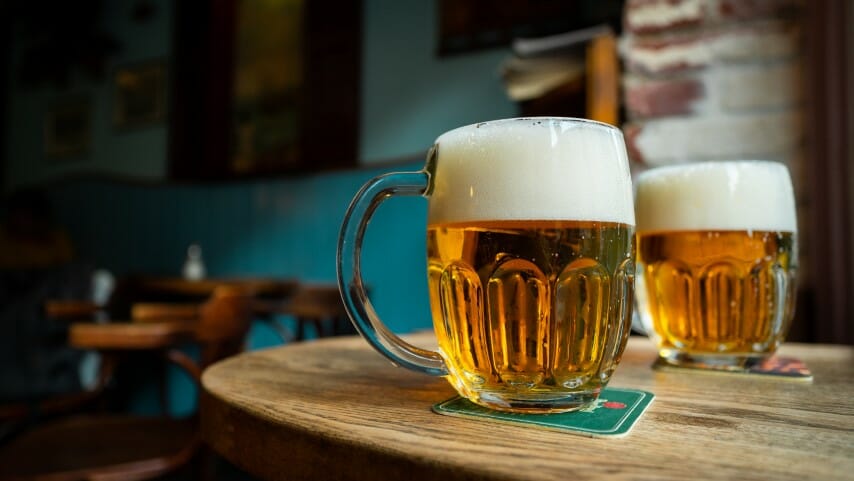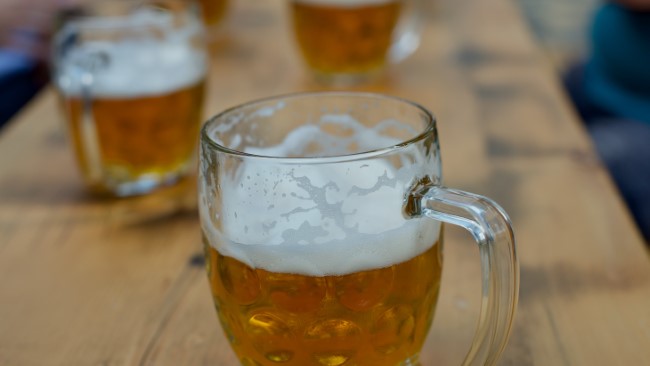Craft Beer Brewers Love Obscure Czech Lager and Rauchbier–But Can They Make Average Drinkers Care?
Photos via Unsplash, Radovan, Bohdan Stocek
If you spend enough time around professional craft beer brewers, you’ll likely realize that they tend to share a handful of traits in common as a subset of the overall beer drinking population. For one, they’re typically open to experimentation and novelty—hardly a surprising trait for them to possess, but important in the sense that brewers tend to appreciate diversity and eclectic flavors more than the average person, who is more likely to find favorite niches and then stick with them. Professional brewers are explorers, but at the same time they’re also beer omnivores—I have never seen any group of people so happy to pound cans of Busch Light as groups of professional brewers after a big beer festival. To these beer geeks, there’s a time and a place for everything.
In the last few years, however, I’ve wondered if a rift has perhaps been forming—a gap in enthusiasm between the beer styles that brewers are excited about and the ones that the average consumer is excited about. It’s an ideological divide, if you will, one that seems to have steadily grown larger, but not a topic I’ve often seen addressed. It’s something I’ve thought about expounding on a few times, but not until last weekend did I run across a scenario that perfectly seemed to illustrate the situation, a dramatic example of just how far “beer brewer” and “beer drinker” tastes may have drifted apart.
In my opinion? The beer world is more than ready for some dramatic overhauls, and a marked increase in the diversity of styles/flavors that are widely available. The beer styles that excite these brewers represent exactly that kind of evolution … but can they make the average drinker care about them? Can they make these styles commercially viable, that you might be able to walk into a grocery store and find cans sitting on the shelf, next to 100 IPA and kettle sour brands? That’s the real question.
A Very Unusual Festival
Last weekend, I attended a modest beer festival from beloved Richmond, VA staples Triple Crossing, the return of what had been an annual, pre-COVID staple, called Covenant. It was a beautiful little fest, but it only took one glance at the overall beer list to confirm that it was a very unusual beer festival as well. Put simply, it was shocking to look at the collection of 18 guest breweries and see just how little hop-forward beer they chose to bring and pour, giving the lineup a feel that was immediately alien to the modern beer festival mold. In place of the IPAs, sours and stouts you’d probably be expecting? Tons and tons of lager, multiple smoked beer styles, plentiful farmhouse ales and others. It was the clearest and most concise illustration I’ve ever seen of the differences between what the brewers are currently excited about, and what the rank and file drinkers are excited about. This was not a lager-themed festival, either—it’s simply what those breweries chose to bring and present.
In terms of the numbers, the festival beer list contained the following. One pale ale. One standard American IPA. One DIPA. And one “sour IPA.” That was it for the hop-forward styles. As for something like imperial stout? There were merely two pouring. Now ask yourself: When’s the last time you were at a beer festival and there was one standard strength IPA between all the guest breweries in attendance? Granted, Triple Crossing also had a wide array of its own award-winning IPAs at the main bar, but the point still stands. Albeit in a small-ish sample size, this was a far cry from the composition of the typical beer festival in 2022.
What were they pouring instead? Well, there were half a dozen pilsners in various styles, half a dozen dark lagers, and numerous other lagers of nebulous styles. There was rauchbier, and grodziskie. There were unclassifiable farmhouse ales one could at least call in the neighborhood of saison, and eclectic wild ales, with and without fruit.
 Dimple mugs: The new hotness.
Dimple mugs: The new hotness.
Get this: There was not one but two disparate examples of “Polotmavý Ležák,” an obscure Czech lager style that even I, a person who has spent more than a decade writing about beer, had never heard of before the festival. Which is to say, there were more examples of Polotmavý Ležák at this festival than there were examples of standard-strength American IPA. How improbable is that?
What is that style, you might be wondering? Well, in the Czech it roughly translates to “half dark” lager, implying a beer with a dark brownish hue—notably, that makes it lighter in color than the mostly black tmavé pivo, what we now widely refer to as “Czech dark lager” at many breweries. It’s a subtle variation, similar perhaps to the difference between dunkel and schwarzbier in the German brewing lexicon. On the palate, it’s malty and toasted, nutty and slightly roasty, with a characteristic that homebrewers would recognize as being similar to the profile of Melanoidin Malt. In short, it was lovely; it was novel; it was the kind of fresh experience that has been too often missing from my beer exploration in the last few years. And I want some more of it, pronto.
These are the kinds of styles that I now see brewers gravitating toward, at breweries across the country. Subtle variations on Continental lagers, hailing from a wide array of countries. Historic English ales. Quirky farmhouse ales that defy categorization. Different modes of presentation, such as side pull faucets, which help achieve specific textures in the beer they’re serving. Forgotten styles resurrected and celebrated, and a greater focus on appreciation for styles that present their flavors with delicacy and subtlety rather than simply smashing as intense a profile as possible down drinkers’ throats.
It’s hard not to see this appreciation from those professional brewers as something of a rejection of the most prevailing tastes in the craft beer world, which run in the exact opposite direction. The world of hype IPA is still dominated by its never-ending quest to out-juicy each week’s “new” hazy IPA release, and although West Coast IPA has also seen its own hype resurgence, those resurrected beers rarely have much in common with what we were calling “West Coast IPA” a decade or more ago. Over by the kettle sours, over-the-top fruit and smoothie profiles continue to be the dominant trend. In the world of stout, adjuncts rule more than ever, and one is lucky to find an imperial stout that merely contains vanilla or coffee, rather than maple, breakfast cereal, or sleeves of Oreos. The prevailing trends continue to foster a beer culture built around saccharine, cloying beers full of sugar, with bombastic flavors seemingly designed to appeal primarily to drinkers who detest the very idea of subtlety.
How Do You Sell Beer Drinkers on Subtlety?

That’s the question, and I’d be lying if I said that I had an answer to it. Professional brewers certainly seem to have cultivated a thriving appreciation for the kinds of subtle or more obscure styles that were bizarrely well-represented at the festival I highlighted above, but at those same breweries, geeks standing in line to buy pallets of hazy IPA is still the norm. And keep in mind: Those beer geeks buying trunkfuls of hazy IPA aren’t even really the core craft beer drinker—those would be the people buying six- and 12-packs of mass-market IPA from the grocery store cooler aisle. To those drinkers, hazy IPA, smoothie sour and pastry stout likely still seem like the cutting edge, avant garde of the beer world. They’re not running across Polotmavý Ležák at the local Kroger.
Earlier this year, I wrote about how the craft lager boom was the best thing happening in the modern beer world, but it’s a “boom” in a somewhat relative sense. Those who spend a lot of time visiting brewery taprooms are most likely to have noticed the greater availability of those lager styles—your pilsners, helles, dark lagers, etc.—because many of those beers have a tendency to be presented by their breweries as taproom exclusives. Clearly, this implies second class economic status for these styles: The brewers like to make them and drink them, and there’s an undercurrent of commercial drinkers who appreciate them, but most simultaneously don’t sell well enough to justify putting into bottles and cans. If tmavé pivo was a top seller, surely we’d see it well represented on store shelves, but instead one often has to settle for a pint at the local taproom.
One would hope that with time and evangelizing from those very brewers, this landscape might start to change. Festivals like the one I described above are surely a good start, as they give an invaluable opportunity for attendees to discover new styles, and perhaps even speak with the brewers about what they believe makes an obscure Czech lager just as vital a beer experience as a well-made IPA. Perhaps more beer drinkers would begin to take an interest, if they had a sense of what styles were increasingly popular among the men and women brewing their beer.
At the same time, though, it’s easy to feel cynical about the prospect of these styles ever truly breaking through to the more mainstream craft beer drinker. Outside of something of an awareness for the still frequently misunderstood idea of “pilsner,” the craft lager revival has seemingly been cordoned off within a subculture of the beer world, and has made little inroads with Joe Craft Sixpack. I sincerely hope that’s enough to, at the very least, keep availability of these styles where they are today, easily found within the taproom setting. But I hope even more than the professional brewers out there are able to bring their love for these styles more fully to the masses, and in the process open the eyes of the average craft beer drinker to a significantly wider and more delicately flavored world.
Jim Vorel is a Paste staff writer and resident beer and liquor geek. You can follow him on Twitter for more drink writing.